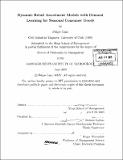| dc.contributor.advisor | Jérémie Gallien. | en_US |
| dc.contributor.author | Caro, Felipe | en_US |
| dc.contributor.other | Sloan School of Management. | en_US |
| dc.date.accessioned | 2006-07-13T15:22:25Z | |
| dc.date.available | 2006-07-13T15:22:25Z | |
| dc.date.copyright | 2005 | en_US |
| dc.date.issued | 2005 | en_US |
| dc.identifier.uri | http://hdl.handle.net/1721.1/33415 | |
| dc.description | Thesis (Ph. D.)--Massachusetts Institute of Technology, Sloan School of Management, 2005. | en_US |
| dc.description | Includes bibliographical references (leaves [104]-108). | en_US |
| dc.description.abstract | The main research question we explore in this dissertation is: How should a retailer modify its product assortment over time in order to maximize overall profits for a given selling season? Historically, long development, procurement, and production lead times have constrained fashion retailers to make supply and assortment decisions well in advance of the selling season, when only limited and uncertain demand information is available. As a result, many retailers are seemingly cursed with simultaneously missing sales for want of popular products, while having to use markdowns in order to sell the many unpopular products still accumulating in their stores. Recently however, a few innovative firms, such as Spain-based Zara, Mango and Japan-based World Co. (referred to as "Fast Fashion" retailers), have gone substantially further, implementing product development processes and supply chain architectures allowing them to make most product design and assortment decisions during the selling season. Remarkably, their higher flexibility and responsiveness is partly achieved through an increased reliance on more costly local production relative to the supply networks of more traditional retailers. | en_US |
| dc.description.abstract | (cont.) At the operational level, leveraging the ability to introduce and test new products once the season has started motivates a new and important decision problem, which seems crucial to the success of these fast-fashion companies: given the constantly evolving demand information available, which products should be included in the assortment at each point in time? The problem just described seems challenging, in part because it relates to the classical trade-off known as exploration versus exploitation, usually represented via the multiarmed bandit problem. In this thesis we analyze the dynamic assortment problem under different sets of assumptions, including: (i) without lost sales; (ii) with lost sales but observable demand; (iii) with lost sales and censored information; and (iv) with time varying demand rates. In each case we formulate an appropriate model and suggest a (near-optimal) policy that can be implemented in practice, together with associated suboptimality bounds. We also study the incorporation of substitution effects and the extension of the models to a generic family of demand distributions. The common solution approach involves the Lagrangian relaxation and the decomposition of weakly coupled dynamic programs. | en_US |
| dc.description.abstract | (cont.) The dissertation makes three contributions: (1) it is the first attempt in providing mathematical optimization models with near-optimal solutions for the dynamic assortment problem faced by a fast-fashion retailer; (2) our analysis contributes to the literature on the multiarmed bandit problem, in particular for its finite-horizon version, we derive a general closed-form dynamic index policy that performs remarkably well; and (3) the solution approach contributes to the emerging literature on duality in dynamic programming. | en_US |
| dc.description.statementofresponsibility | by Felipe Caro. | en_US |
| dc.format.extent | 108 leaves | en_US |
| dc.format.extent | 6433458 bytes | |
| dc.format.extent | 6437947 bytes | |
| dc.format.mimetype | application/pdf | |
| dc.format.mimetype | application/pdf | |
| dc.language.iso | eng | en_US |
| dc.publisher | Massachusetts Institute of Technology | en_US |
| dc.rights | M.I.T. theses are protected by copyright. They may be viewed from this source for any purpose, but reproduction or distribution in any format is prohibited without written permission. See provided URL for inquiries about permission. | en_US |
| dc.rights.uri | http://dspace.mit.edu/handle/1721.1/7582 | |
| dc.subject | Sloan School of Management. | en_US |
| dc.title | Dynamic retail assortment models with demand learning for seasonal consumer goods | en_US |
| dc.type | Thesis | en_US |
| dc.description.degree | Ph.D. | en_US |
| dc.contributor.department | Sloan School of Management | |
| dc.identifier.oclc | 62763265 | en_US |
